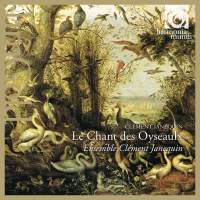Texte paru dans: / Appeared in: |
|
|
Outil de traduction ( |
|
|
|
|
|
Reviewer: J.
F. Weber This is the third collection of Janequin songs we've had from this label lately, and while it doesn't duplicate anything in the collection of Janequin and Sermisy from the same ensemble {Fanfare V:6), It does give us the featured song and Le chant du rossignol (sung several times faster!) which appeared on an earlier disc which HM recently reissued {Fanfare IV:5). The success of the ensemble's first disc Is enough reason for them to come back with a full LP of mostly less familiar songs. In fact, these are not the alliterative, onomatopoeic creations that Janequin is so noted for, apart from the two familiar titles just mentioned and Le chant de l'alouette. The rest are all love songs, sung with the same affection that the group displayed for their namesake earlier. A quick check of several earlier Janequin LPs indicates that most of these have not been recorded much, if at all. Two of the 20 selections are lute arrangements by Morlaye and Rippe of Janequin melodies. The sound is typical of this label's high standard, even if it's a coproduction with Radio France; the French pressing, however, is a shade less quiet than the superb German pressings they've furnished lately. That's still better than most. An attractive cover painting and a booklet with notes, texts, and translations is part of the package. There aren't many competing collections, so this can be recommended easily.
This article originally appeared in Issue 06:6 (July/Aug 1983) of Fanfare Magazine.
As noted
in the original review (Fanfare VI:6), this has only a few of the
tongue-tripping bird songs for which this composer is uniquely celebrated.
The 18 songs (and two tablatures by Morlaye and Rippe) are mostly love songs
with a smooth lilt to them. (A program which alternated from one type to the
other throughout would offer delightful contrast.) Each song is tracked, and
notes, texts, and translations are carried over in full. One departure I
haven't seen before: Instead of reducing the cover art, a same-size detail
is taken off the sleeve. I defy anyone to put the CD on, listen to the
beginning of the first track, and declare on the evidence of his ears that
the sound which leaps out of the silence is not digital (it's not). | |
|
|
|
|
|
|
|
Cliquez l'un ou l'autre
bouton pour découvrir bien d'autres critiques de CD |
|



